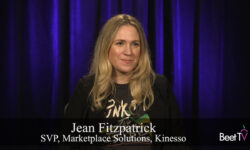Discovery bought a 10% interest in OpenAP, the ad-targeting consortium whose owners include NBCUniversal, Fox and ViacomCBS.
The media companies founded OpenAP in 2017 to create tools to help brands harness consumer data to improve the targeting of their advertising campaigns among several TV networks.
Discovery in April had integrated OpenAP’s OpenID identifier for cross-platform measurement, and partnered with OpenAP on last month’s launch of XPm, a measurement framework backed by media companies, according to an announcement. Discovery’s network brands include HGTV, Food Network, Animal Planet and TLC.
“We are grateful for the increased commitment Discovery is making to work alongside us on this journey of propelling further growth of the marketplace,” David Levy, chief executive of OpenAP, said in a statement.

In this video interview for Beet.TV’s Beet Retreat, Levy discusses the challenges with developing consumer identifiers that help advertisers with their audience targeting and measurement of reach and frequency.
Responding to the problem
“One of the challenges going forward from an identity perspective is certain big platforms not passing any identity on an impression or even passing the ability to know,” Levy says to The Project X Institute co-founder Jon Watts. “It’s challenging with frequency capping, (there are) challenges with identification on impressions. So, I think one of the big issues is going to be, we’re going to have some black holes in our data, going forward. How we continue to respond to that is going to be pretty key.”
Identity Graphs Are Learning To Talk To Each Other: OpenAP’s Davis
OpenID rising
OpenAP was kickstarted by Fox, Viacom and NBCUniversal, later adding Univision, as a broadcast industry effort to smooth the path to targeted TV advertising.
First, it aimed at harmonizing the metadata descriptions used by a variety of TV broadcasters in order to make selling more scaleable. Then it made a step-change by launching an actual marketplace through which ad buyers can purchase data-driven TV ad.
OpenAP this year picked TransUnion, following its TruOptik acquisition, to power its OpenID.
And that, viewer identity, is where so much of the industry’s focus has fallen.
Marrying linear and digital
“Previously, the audiences that we’ve been using for television have been demographic audiences fuse to linear specific data,” Levy says.
“By definition, that’s not an audience segment that can act actually be used across multiple different devices.
“Why is an ID spine so necessary and central to cross platform measurement?
“It’s because, in order for you to enable cross-platform measurement, the first piece that you need to do is be able to define an audience against an ID spine that doesn’t just represent linear viewers, it doesn’t just represent digital viewers, but that represents the whole US.”
This week we announced the launch of OpenID, a unique identifier that resolves linear & digital audiences. Adopted by premium TV networks, OpenID gives advertisers the clearest path toward omni-channel planning, optimization & measurement. Read more here: https://t.co/yNV6oM4Agm pic.twitter.com/4cCoNHqSqF
— OpenAP (@OpenAPTV) April 30, 2021
Identity games
Numerous actors are now playing in the space, with offers from Blockgraph, Experian, TransUnion, LiveRamp, TradeDesk, OpenID and others.
For OpenAP’s Levy, despite picking TransUnion, “interoperability” is the watchword.
“We’re also going work with other providers as well,” he says. “For us, what’s really important is that we have an ID spine that maps to everyone in the US, and then it can actually be interoperable with multiple ID spaces.
“So, regardless if someone uses Experian or LiveRamp or has their own ID solution like Nielsen, we have the ability to easily map our audiences or our data to those environments as well.”
Everyone welcome
OpenID has been working at connecting with data providers like Axiom, Epsilon and Merkel, to a swathe of publisher endpoints, and to the measurement currencies.
“We’re working to be interoperable with UID and other things like that, too,” Levy says, adding that, whilst a single identity “spine” is important, it is also important that people can connect multiple solutions.
“That doesn’t necessarily mean that there’s one ID that everyone has to use,” he says. “Publishers are going to have different ID systems.
“But it is important for a brand that actually wants to track who they’re reaching cross-platform, not only on one campaign but on multiple campaigns.”
“So that they have an understanding of what their optimal frequency is, there does need to be consistent spine that they’re mapping back to for everything that they’re doing.”
You are watching coverage from Beet Retreat Santa Monica 2021, presented by FreeWheel, IRIS.TV, Samba TV, TransUnion & Warner Music Group. For more videos, please visit this page.














































